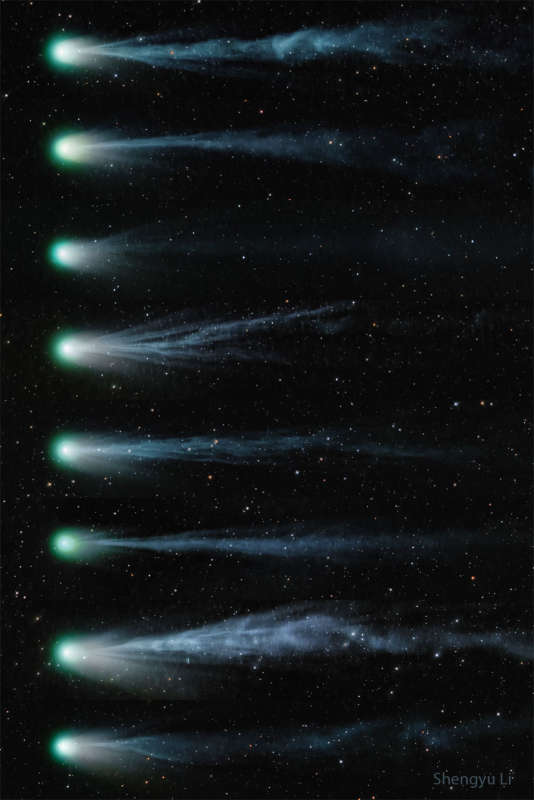
|
Credit & Copyright: Shengyu Li & Shaining
Explanation:
How does a comet tail change?
It depends on the comet.
The ion tail of
Comet 12P/Pons┴Brooks has been changing markedly,
as detailed in the featured image sequenced over nine days
from March 6 to 14 (top to bottom).
On some days, the comet's
ion tail was relatively long and complex,
but not every day.
Reasons for tail changes include the rate of
ejection of material from the
comet's nucleus,
the strength and complexity of the
passing solar wind, and the
rotation rate of the
comet.
Over the course of a week, apparent changes even include a
change of perspective from the Earth.
In general, a comet's
ion tail will point away from the Sun,
as gas expelled is pushed out by the
Sun's wind.
Today,
Pons-Brooks
may become a rare comet
suddenly visible in the middle of the day for those able to see the
Sun totally eclipsed by the Moon.
NASA Coverage:
Today's Total Solar Eclipse
Total Eclipse Imagery:
Notable Submissions to APOD
|
January February March April May June July August September October November December |
| ||||||||||||||||||||||||||||||||||||||||||||||||
NASA Web Site Statements, Warnings, and Disclaimers
NASA Official: Jay Norris. Specific rights apply.
A service of: LHEA at NASA / GSFC
& Michigan Tech. U.
Based on Astronomy Picture
Of the Day
Publications with keywords: comet
Publications with words: comet
See also:
- APOD: 2025 December 1 ┴ 3I ATLAS: Tails of an Interstellar Comet
- APOD: 2025 November 25 ┴ Comet Lemmon and the Milky Way
- 3I/ATLAS: A View from Planet Earth
- APOD: 2025 November 17 ┴ Comet Lemmons Wandering Tail
- APOD: 2025 September 30 ┴ Comet Lemmon Brightens
- APOD: 2025 September 29 ┴ Two Camera Comets in One Sky
- APOD: 2025 September 26 ┴ A SWAN an ATLAS and Mars
